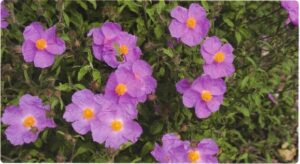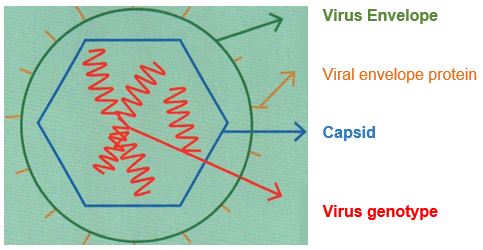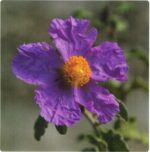Viruses – Masters of Camouflage
Natural Healing Strategies for Prevention
For Readers in a Hurry
The extract of Cistus x incanus L. Pandalis makes it impossible for viruses to force an entry into host cells and to multiply. This reduces the virus load and gives the adaptive immune system the time to learn a specific immune answer for the remaining pathogens. Also attention is paid to a sufficient supply of vitamins and minerals, especially zinc.
 A basic condition of all life is the constant exchange between individuals with their environment. But not everything this environment holds in readiness is also beneficial, some are even deadly. This can be due to the great aggressivity of pathogens and/or in that they are not recognized by the immune system or they change quickly. Thus the determining question is: How do we thus bring our immune system into an optimal position for unknown challenges, so that it can also adequately meet dangerous new viruses?
A basic condition of all life is the constant exchange between individuals with their environment. But not everything this environment holds in readiness is also beneficial, some are even deadly. This can be due to the great aggressivity of pathogens and/or in that they are not recognized by the immune system or they change quickly. Thus the determining question is: How do we thus bring our immune system into an optimal position for unknown challenges, so that it can also adequately meet dangerous new viruses?
All creatures developed their own defensive strategies for protection against attacks from the outside. Additionally, the cell membrane which shields the sensitive processes inside of the cell from the outside world already includes micro-organisms at the most basic level. Even though plants do not possess an adaptive immune system like animals, nevertheless their unspecific immune system can be understood as a correlation to the innate immune system of animals(1). Thus, plants react to intruders for example by increased formation of secondary plant materials with antibacterial characteristics or through strengthened synthesis of lignin, in order to prevent pathogen propagation through a physical barrier(2). The adaptive immune system of animals – and thus also for us people – is even more flexible: It learns through contact with unknown pathogens and is thus very well armed for a renewed infection thanks to specific antibodies. However, the efficiency of the immune system is limited. Over and over again there are pathogens that leave us seriously ill.
Enveloped and Non-Enveloped Viruses
The different pathogenicity of various virus types clarifies the observation of two basic characteristics that are also considered for the classification of viruses. A first classification criterion is the question about the viral envelope. With non-enveloped viruses, the virus genotype is surrounded with a mostly symmetrical protein capsule, the capsid. That capsid gives its external structure to the virus and interacts directly with the host cell at penetration. As a rule, non-enveloped viruses can leave their host cell after replication only by means of lysis (destruction of the host cell).
Compared with adverse environmental influences like dryness, disinfectant solutions or detergents, non-enveloped viruses usually are clearly more resistant than enveloped viruses. However, a non-enveloped virion is directly exposed to the immune cells which in this manner can quickly recognize it as foreign(3). Otherwise for the viruses with envelope: Their external lipid double membrane derives originally from the host cell in which, however, the viral is stored instead of the cellular membrane protein. Either the virus envelope derives from the cell membrane or the membrane of the Golgi Apparatus, or rather the endoplasmic reticulum. A capsid is usually (but not always) found in the virus envelope, which on the other hand includes the virus genotype(3). The great advantage of the enveloped viruses is that through their camouflage they can better escape from recognition by the immune system.
 Figure 1: Schematic structure of an enveloped virus.
Figure 1: Schematic structure of an enveloped virus.
Enveloped viruses are also recognized by the immune system sooner or later, because the viral proteins in the virus envelope are foreign. Moreover, during evolution enveloped viruses have developed mechanisms which favor their increase and are designated as virulence factors. Molecular mimicry is one of those mechanisms: As a result the virus envelope protein is produced with great similarity to their hosts whereby they are not recognized as foreign and escape the immune system. Thus the virus reaches a high immunological flexibility through its envelope which permits the increase of the various host species(4). This aspect is of particular importance in the emergence of new pandemics like the SARS-CoV-2 which leaped over from an animal and lead the way to humans.
Enveloped viruses better escape recognition by the immune system through their camouflage.
DNA and RNA Viruses
The second classification criterion concerns the viral genome which can be present as DNA or RNA. As a rule the genotype of the DNA viruses is less variable, which makes it easier for the immune system and for vaccine development. Thanks to their greater chemical stability DNA viruses are less inclined to spontaneous changes due to environmental factors than are RNA viruses. Moreover the mutation rate for DNA viruses is low, because they use DNA polymerase in the course of their replication which has a low error rate(5). However, RNA viruses are extremely variable. They are quickly inclined to changes under environmental influences. Besides, RNA polymerase is used for virus replication which has a one to 1,000 times higher error rate than DNA polymerase(6).
Thus taken together it is clear that enveloped RNA viruses represent a particular threat because they can easily escape the immune system, adapt themselves quickly and develop resistance.
RNA viruses are extremely variable and mutate faster than DNA viruses.
In fact almost all viral pathogens in recent times fulfil these criteria with pandemic potential. The following small selection shows some old and new acquaintances and perhaps gives a forecast of possible pandemics of the future:
Selection of enveloped RNA viruses:
- HIV virus
- SARS-CoV-1 and SARS-CoV-2
- Influenza virus
- Hantavirus
- Ebola virus
- West Nile virus
- Rubella virus (German measles)
- Measles virus
- TBEV (FSME) virus
- Zika virus
- Human T-lymphotropic virus
- Human Parainfluenza virus
Vaccination and Causal Therapy
However, the first three representatives in this selection, thus from HIV virus to the Influenza virus, together are responsible for over 1.7 million deaths every year(7-9). Clinical medicine pursues two basic approaches for these infectious illnesses: Preventive treatment (e.g. by means of vaccines) and causal therapy. Vaccines are only effective when a virus does not change too often and too fast and the body forms sufficient and long lasting antibodies. Both aspects can be problematic with enveloped RNA viruses which is indicated in the notoriously low success of the annually adjusted influenza vaccine. In 2017-18 in Germany the effectivity of the flu vaccine lay at only approx. 15%(10). For the current rampant Coronavirus indications increase that the number of antibodies sinks quickly after getting over an infection(11, 12). Should this be confirmed, this would clearly curtail the prospects of success of an effective vaccination strategy.
Also, the specific development of a single substance against a virus and its replication cycle is extremely difficult. During replication a virus makes use of many different enzymes and building blocks from its host cells. This makes it difficult to develop an active ingredient precisely in such a way that it is directed selectively only against infected cells and not against healthy ones. Accordingly the side effects are often strong.
In the best case the active ingredient only attacks one specific viral target structure.
In the best possible case an active ingredient attacks only one specific viral target structure. The reverse of this high specificity in many cases is a fast resistance build up. The prime example for this is the known influenza remedy Tamiflu (active ingredient Oseltamivir). Already after a short time flu viruses develop a resistance that quickly leads to the entire loss of effectiveness. In the 2007-2008 influenza season resistance to Oseltamivir had been proven in some European countries and already affected 13% of the analyzed tests(13). In the following 2008-2009 influenza season almost all analyzed virus tests were resistant to Oseltamivir(14) by around 98%.
The reverse of a highly active ingredient specificity is a quick resistance buildup.
Not only in view of COVID-19, the basic question posed is how successful the present strategies can be. Even if they succeeded over and over again in developing new preparations for specific prophylaxis or therapy, a critical time window always remains.
Alternative Strategies
“Prevention is better than healing” – there is the wisdom of the physician Christoph Wilhelm Hufeland (1762-1836). The Hufeland-Prize is named after him which is given annually to doctors for achievements and outstanding research results pointing the way in preventative medicine. In spite of their age of around 200 years, the words of Hufeland have actually lost nothing. Especially if no adequate therapy is available, prevention is the only possible measure.
The best prevention is good nutrition. Because the immune system – as well as all other bodily functions – is dependent on the supply of nutrients which ideally are supplied by a well balanced diet with self-prepared meals. Aside from the meditative aspect which preparation can mean, self-preparation is vital above all for the nutrient composition of the meals. In highly processed read-to-serve meals, the content is clearly changed and strongly reduced in important minerals and vitamins(15).
With regard to a healthy function of the immune system confirmed knowledge is available for the following vitamins and minerals:
- Vitamin A, Vitamin B6, Vitamin B12, Vitamin D and folic acid.
- Iron, copper, selenium and zinc
The role of zinc is particularly interesting. Some reviews of it attest to a good effect with colds. For example, taking 75 mg on the first day of a cold shortens the illness length on average about one day – the exact mechanism is still unresolved(16). For rhinoviruses a replication inhibition with zinc could be shown in-vitro(17). Newer investigations concentrate on another aspect: According to this zinc acts as a negative regulator on monocytes. Monocytes can be classified as precursor cells of the macrophages and of the dendritic cells both for the unspecific as well as the adaptive immune system. Zinc causes the attenuation of the overshooting immune reaction and thus regulates down the damaged inflammation reactions(18). The concept of the “cytokine storm” describes such overshooting inflammation reactions and has come into focus with COVID-19 because over-strong inflammations are decisively responsible for severe courses(19). In conclusion, whether zinc has a prophylactic effect before an infection is not yet conclusively clarified because of the thin and irregular data situation.
 Figure 2: Cistus
Figure 2: Cistus
The Time Factor
Despite its enormous efficiency and adaptability, again and again there are situations in which our immune system is overtaxed. This can be the case if we are confronted with a new pathogen. The adaptive immune system must adapt itself anew in such a situation. Until it has a purposeful answer to the new pathogen, some days pass. During this time it is the task of the innate (unspecific) immune system to keep the infection in check. It is therefore of crucial importance how many viruses the immune system must stand up to until it is ready for a specific answer. With too large virus amounts, it can come to a severe illness course or even to death.
Nature offers some effective possibilities for providing the time the adaptive immune system needs. Very well investigated and currently in focus is the special cistus variety Cistus x incanus L. Pandalis. The high-polymeric polyphenols of Cystus 052® Extract gained from it bind unspecifically to the surface of the virus and leave the body cells untouched(20, 21). Therefore it is impossible for viruses to penetrate into the host cells and to multiply. This active mechanism has been confirmed with a whole series of different viruses, among others with MERS-Coronavirus(22). Particularly throat lozenges (2 lozenges 3 times daily) have been proven in clinical studies, which besides are very simply used(23). You dissolve these slowly in the mouth so that the ingredients are released bit-by-bit and completely protect the oral mucosae long lastingly.
The virus load reduced in such a way can easily keep the innate immune system in check. At the same time the adaptive immune system has the possibility to learn a specific immune answer to the remaining pathogens. After an endured infection the defence is prepared for the next pathogen contact and in the best case you are even immune for life. Such a natural immunity is not only side effect free, in the case of the seasonal influenza (Influenza A) it was shown that thus also a certain protection originates against other virus subtypes(24). There are already indications that the cross immunity mechanism also functions with SARS-CoV-2 from which an additional use arises from the application(25).
The minimization of risk factors, an adequate supply of vitamin and mineral substances and the easing of the burden on the immune system are the best conditions for a successful defence, also from new enveloped RNA viruses. This is shown from the vast majority of mild COVID-19 courses and a current practice observation.
From the Practice
In a retrolective study with 125 participants the Nisita Nasensalbe* and the Cystus 052 Bio Halspastillen** (2 lozenges 3-times daily) were used for at least 6 weeks. At the end of the period of observation none of the participants had been infected with SARS-CoV-2.
Especially interesting is the fact that members living in the homes with 9 of the participants fell ill with COVID-19, but the participants who took the throat lozenges were not infected. This was confirmed by means of PCR analysis(26).

An Exclusive Translated Article for P2P Supporters
From the Monthly Publications of P2P
Published February 2021
From an article in Naturheilpraxis, Volume 73, October 2020
Machine Translation by SYSTRAN, Lernout & Hauspie, LogoMedia & Promt
Translation & redaction by: Carolyn L. Winsor, P2P Consulting
© Copyright 2020, Sylvia Püttmann, DSc, HP, Germany
Literature
- Jones JDG, Dangl JL: The plant immune In: Nature. Bd. 444, Nr. 7117, November 2006, 323-29
- Miedes E, Vanholme R, Boerjan W, Molina The role of the secondary cell wall in plant resistance to pathogens. Front Plant Sci. 2014;5: 358
- Uhlenhaut C: Tenazität von Viren – Stabilität und Erhalt der Infektiosität von Viren, In: Proceedings: Biologische Gefahren in Deutschland, Band 6, Bundesamt für Bevölkerungsschutz und Katastrophenhilfe, Bonn 2011
- Modrow S, Falke D, Truyen U, Schätzl H: Molekulare Virologie, Springer-Verlag, 2010
- Beyer H, Walter W: Lehrbuch der organischen Chemie. 23. Auflage Hirzel, Stuttgart 1998
- Sanjuan R, Nebot MR, Chirico M, Mansky LM, Belshaw R: Viral Mutation Rates. In: Journal of 84, Nr. 19, 2010, S. 9733-48
- Global HIV & AIDS statistics —2020 fact sheet, Unaids, n.rpv. media/11x, abgerufen am 14.07.2020
- WHO Coronavirus Disease (COVID-19) Dashboard, n.rpv. medianly, abgerufen am 14.07.2020
- WHO – Up to 650 000 people die of respiratory diseases linked to seasonal flu each year, News release, 13 Dezember 2017
- Buda S, et al.: Bericht zur Epidemiologie der Influenza in Deutschland Saison 2017/18, Robert-Koch-Institut, 2018
- Ärzteblatt: Studien: COVID-19-Genesene möglicherweise nicht dauerhaft immun, Dienstag, Juli 2020
- Seow J, et al: Longitudinal evaluation and decline of antibody responses in SARS-CoV-2 infection, medRxiv 2020.07.09.20148429
- Robert Koch-Institut: Influenza: Zum Auftreten von Resistenzen gegen Oseltamivir bei Influenzaviren des Suptyps A/ H1N1, 1. Februar
- Dharan NJ, LGubareva LV, Meyer JJ, et al.: Infections With Oseltamivir-Resistant Influenza A(H1N1) Virus in the United States. In: JAMA. 2. März 2009, Band 301, Nr. 10
- Niggemeier CM: Untersuchungen zum Einfluss von Lebensmittelverarbeitung und -verarbeitungsgrad auf die Energie-, Nährstoff-und Zusatzstoffzufuhr von Kindern, Jugendlichen und Erwachsenen, April 2017
- Singh M, Das RR: Zinc for the common cold. Cochrane Database of Systematic Reviews 2013, Issue 6. Art. No.: CD001364
- Al-Nakib W, Higgins PG, Barrow 1, Batstone G, Tyrell DAJ: Prophylaxis and treatment of rhinovirus colds with zinc gluconate lozenges. Journal of Antimicrobial Chemotherapy 1987;20: 893-901
- Liu MJ, Bao S, Gälvez-Peralta M, et al: ZIP8 regulates host defense through zinc-mediated inhibition of NF-KB. Cell Rep. 2013;3(2): 386-400
- DAZ: COVID-19 – Diese Arzneimittel testen Forscher gegen Zytokinstürme, 29.05.2020
- Droebner K, et al.: The polyphenol rich plant extract CYSTUS 052 is highly effective against H5N1 and pandemic H1N1v influenza A virus. Influenza. Other Respi Viruses 2011; 5 (Suppl. 1): 237-39
- Ehrhardt C, et al.: A polyphenol rich plant extract, CYSTUS 052, exerts anti influenza virus activity in cell culture without toxic side effects or tendency to induce viral resistance. Antiviral Research 2007. 2238.1-10
- Apotheke Adhoc: Cystus gegen Coronavirus: „RKI unfähig oder gleichgültig”,03.2020
- Kalus U, Grigorov A, Kadecki 0, et al. : Cistus incanus (CYSTUS 052) for treating patients with infection of the upper respiratory tract. A prospective, randomised, placebo-controlled clinical study. Antiviral Res 2009; 84: 267-71
- Bodewes R, et al.: Yearly influenza vaccinations: a double-edged sword? Lancet Infect 2009 Dec:9(12): 784-8
- Wang C, Li W, Drabek D, et al.: A human monoclonal antibody blocking SARS-CoV-2 infection. Nat Commun 11, 2251 (2020)
- Adler M: Retrolektive Therapiebeobachtung im Rahmen der Pandemie mit Covid-19, in Zeitschrift für Phytotherapie 2020; 41(03): 111-112
Translator Footnotes:
All diagrams and pictures have been “borrowed” without permission from the journal only for your information and to maintain the flow and perspective of Dr. Püttmann’s article.
* Nisita nasal ointment
** Cystus 052 Bio Throat Lozenges



